Development Technology of Synbiotic Yogurt With Cholesterol Lowering Ability
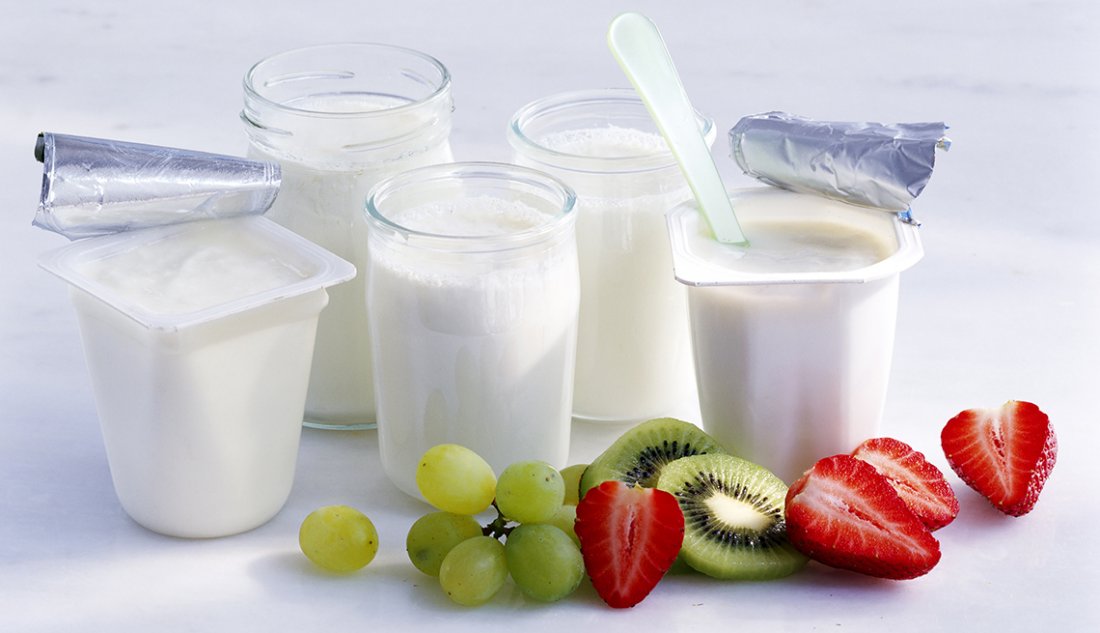
Abstract – The aim of this study is to determine the development technology of synbiotic yogurt with cholesterol lowering ability. The strains of lactic acid bacteria with cholesterol lowering ability was used as the stater cultures of AM2-6 and BM2-5. Inulin and Fructooligosaccharides was used for prebiotic combination. The most desirable conditions according to the Box-Behnken design was 1.77:1 of inoculation rate, 5 g/100g of inoculum, under 41.92℃ fermentation temperature in the condition 1.0% inulin, at the prediction of 98.0%. And 1.89:1 of inoculation rate, 5 g/100g of inoculum, under 42.87℃ fermentation temperature in the condition 1.5% FOS, repectively, at the prediction of 82.3%. The results of the orthogonal experiment by Box-Behnken design were consistent with the optimal condition results of single factor experiment in the actual operation which the inoculation rate of 2:1, 5 g/100g of inoculum and fermentation under 43℃.
Introduction
Commercial starter cultures was usually directly inoculated into foods and beverages in industries (Sandine, 1996). At least one functional property contributed to improving food quality in fermentation processes and benefited to producing safety and healthy end products were characterized in the starter cultures (Leroy et al, 2004).
In the recent years, more and more researches on the use of native microorganism isolated from traditional dairy products for natural stater cultures were studied (Peighambardousta et al, 2011; Qinglong et al, 2014). Lactic acid bacteria played an important role in the use of natural stater cultures in fermentation processes of foods and beverages (Jan et al, 2002).
Probiotics are viable microorganism that are beneficial to consumers when ingested into foods and beverages with appropriate quantities (Graham, 2007). Lactic acid bacteria have been used as probiotics (Lactobacilli, Streptococci, Enterococci, Lactococci, Bifidobacteria) over the years (Giuseppe B. et al, 2017; Antonia T. et al, 2017). Health advantages associated by probiotics are improvement of lactose intolerance, increase in humoral immune responses, biotransformation of
isoflavone phytoestrogen to improve post-menopausal symptoms, bioconversion of bioactive peptides for antihypertension, improvement of serum lipid profiles, increase in natural resistance to infectious disease in gastrointestinal tract, suppression of cancer, lower the cholesterol level and improved digestion (Gibson G.R. et al, 1995; Nelly R. V. et al, 2013; Batmunkh M. et al, 2016; Bira N. 2010).
Cholesterol is an organic molecule, a type of lipid. it is biosynthesized by cells and is an essential structural component of cell membranes. It is also the steroid hormones for biosynthesis of bile acid and vitamin D. Hepatic cells produce the greatest amounts (Hanukoglu I., 1992). In general, two-thirds of the cholesterol in the body is endogenously synthesized, and one-third is exogenously ingested. Synthesis within the body starts with the mevalonate pathway by the enzyme 3- hydroxy-3-methylglutaryl CoA (HMG-CoA) reductase and finally synthesized in the body under a series of oxidases action (Wang W., 2009). Exogenous intake of cholesterol is mainly obtained from the diet and current foods are rich in lipids. Thus, a higher intake from food leads to a net decrease in endogenous production and the increase of cholesterol in the blood. Higher cholesterol in blood is associated with risks of heart disease (Grundy et al, 1982; Pyorala, 1987; Gurr, 1992).
Numerous studies about lactic acid bacteria as probiotics with cholesterol lowering ability were occurred in the recent years, especially in various types of characteristic dairy products (Graham et al, 2006). According to the current researches on probiotic lactic acid bacteria, two theories support that to lower cholesterol. One theory is that some in vitro studies showed the cells of lactic acid bacteria can absorb cholesterol when grow in the high cholesterol medium containing bile salts under anaerobic conditions, and reduce the cholesterol content in the medium (Noh et al, 1997). One theory is that some in vitro studies showed the bile salt hydrolase which produced by lactic acid bacteria can deconjugate combined bile acid into free bile acid, then the free bile acid combines with cholesterol into a complex to co-precipitate to lower the cholesterol content (Corzo et al, 1999; Pereira et al, 2003).
The definition of prebiotics are the non-digestible food ingredients that benefit the host through selectively stimulate the growth and/or activity of bacterial species already present in the colon (Gibson et al, 1995). Thus, the effect of prebiotics are neither be hydrolysed nor absorbed in the upper part of the gastrointestinal tract, and selective for bacteria on the colon. A decreasing trend is showed in the numbers of probiotics in human gut with age (Mitsuoka, 1992). To maintain a high level of probiotics, two major strategies have been proposed. To continuously intake foods containing probiotics or supply foods containing prebiotics (Gomes et al, 1999).
Oligosaccharides are the most widely researched prebiotics. It consisting of 2 to 20 sugar units and some occur naturally in foods such as leek, asparagus, chicory, garlic, onion and soybean. There are numerous properties of oligosaccharides which serve the desired attributes in prebiotics. High selectivity and efficiency in metabolism by bifidobacteria and lactobacilli have enabled the supplementation of prebiotics at low dosage (Gibson G. R. et al 2000).
Inulin and Fructooligosaccharides (FOS) are the most studied oligosaccharides for their prebiotic properties. Inulin type fructans contain both glucosyl and fructosyl molecules, the number of fructose units are varying from 2 to 70. A rich source of inulin naturally distributed in the plants. It contains an unique β(2→1) bonds that prevent inulin from being digested by carbohydrate so that reduce the caloric value and increase the dietary fibre effects (S. S. R. Ali et al 2016). The IUPAC/IUB JCBN and the AOAC defined FOS as the fructose oligosaccharide containing 2 to 10 monosaccharide residues linked by glycosidic bonds. Similar to inulin, β(2→1) bonds are also inside FOS and it contributes to resistance towards hydrolysis by human digestive enzymes. Thus, inulin and FOS can pass through the mouth, stomach and small intestine without being metabolized (C. F. Balthazar et al, 2017).
In the previous studies, almost all of the inulin and FOS ingested enters the colon and is completely fermented by colonic microbiota. All these fermentation produced energy, short chain fatty acids and lactic acid. The increase in lactic acid concentrations, decrease the luminal pH to inhibit putrefactive microorganism (Niness, 1999).
Combination of probiotics and prebiotics is called synbiotics. It has synergistic effects that not only promoting growth of the bacteria in the colon, but also improving the survival, implantation and growth of newly added probiotic strains. In the present study, inulin and FOS will be combined with the probiotic Lactic acid bacteria strains for the use in development technology of synbiotic products with cholesterol lowering ability (Oliveira et al, 2009a).
Development technology of synbiotic yogurt with cholesterol lowering ability will be produced under the fermentation process of stirred yogurt production with some modification. The strains of lactic acid bacteria with cholesterol lowering ability was provided by Key Laboratory of Dairy Biotechnology and Engineering, Ministry of Education, China will be used as the stater cultures. Inulin and FOS will be used for prebiotic combination. The combination of probiotic starter cultures and prebiotics will be optimized by the determination of their cholesterol lowering ability. Optimal inoculum and rate of starter cultures, optimal fermentation period and temperature will be selected as the parameter to be confirmed in the development technology of synbiotic yogurt with cholesterol lowering ability through the determination of pH, titradable acidity and viable count.
Material and Methods
1 Milk preparation
Skim milk powder (Anchor, New Zealand) was pretreated and standardized according to GB 19644-2010 and GB 19301-2010. The quality inspection of hydrated milk was determined according to GB 19644-2010.
2 Viable count in prebiotic conditions
Freeze dried cells of the Lb. plantarum strains AM2-6 and BM2-5 with cholesterol lowering ability were used as the production starter cultures for the development technology of synbiotic yogurt (provided by Key Laboratory of Dairy Biotechnology and Engineering, Ministry of Education, China).
It was incubated under different concentration of prebiotic inulin and FOS according to the method by S. S. R. Ali et al, 2016. The viable count of typical strains in the presence of different prebiotic concentrations was determined. The inoculation of prebiotic was under the national standard of GBT 23528-2009.
3 Cholesterol lowering ability on synbiotic effect
The cholesterol lowering ability of each freeze dried strain cells in prebiotic condition was determined according to their cholesterol lowering ability. The cholesterol lowering ability was determined using o-phthalaldehyde method as described by Rudel L. L. et al, 1973 and M.G. Shehata et al, 2016. The experiment of evaluation of cholesterol lowering ability was replicated twice and in comparison with the standard strain Lb. plantarum NBRC 15891T. The optimal addition of prebiotic inulin and FOS was obtained according to their cholesterol lowering ability.
4 Determination of optimal rate of starter cultures
The production process of synbiotic yogurt with cholesterol lowering ability was based on the traditional production process of stirred yogurt with some modification according to GB 19302-2010. Skim milk power was used for milk preparation. The inoculation rate of starter cultures was different in prebiotic condition. The pH value, titratable acidity and viable count of each yogurt was determined.
5 Determination of optimal inoculum of starter cultures
The synbiotic yogurt with cholesterol lowering ability was produced as mentioned above. The starter cultures was inoculated at different inoculum in prebiotic condition.
6 Determination of optimal fermentation period and temperature
The synbiotic yogurt with cholesterol lowering ability was produced under different temperature in prebiotic condition as mentioned above.
7 Box-Behnken design of synbiotic yogurt with cholesterol lowering ability
The optimal production process of the synbiotic yogurt with cholesterol lowering ability was obtained through response surface experiment design. Box Behnken Design was performed using the Design-Expert 8.0.6 software.
8 Physical and chemical analysis of synbiotic yogurt with cholesterol lowering ability
The production process under the optimal fermentation conditions of synbiotic yogurt with cholesterol lowering ability was obtained. The physical and chemical analysis of protein, fat and ash was determined according to GB 5009. 6-2016, GB 5009. 5-2016, and GB 5009. 4-2016, respectively. The total solid content was determined according to GB 5413. 39-2010.
Amino acid were determined using L-8900 amino acid analyzer according to GB 5009. 124-2016. Concentrations of vitamins A and E were determined by RP-HPLC according to GB 5009. 82-2016. Concentrations of vitamins B1 were determined by RP-HPLC according to GB 5009. 84-2016. Concentrations of vitamins B2 were determined by HPLC according to GB 5009. 85-2016. Concentrations of vitamins C were determined by HPLC according to GB 5009. 86-2016.
9 Sensory evaluation of synbiotic yogurt with cholesterol lowering ability
Sensory evaluation was performed by seven trained researchers according to RHB 103-2004.
10 Storage of synbiotic yogurt with cholesterol lowering ability
The synbiotic yogurt with cholesterol lowering ability was refrigerated and stored under 4℃ for 21 days (GB 19302-2010). The pH, titratable acidity and viable count was determined in every 7 days.
Results and Discussions
1 Viable count in prebiotic conditions
Freeze dried cells of the Lb. plantarum strains AM2-6 and BM2-5 were incubated anaerobically under 37℃ for 24 h on the freshly prepared MRS broth. After 20 h of culturing, the MRS broth was centrifuged, and the cell pellet washed twice by D. W.. The supernatant was removed and 0.1 M PBS solutions (pH 6.8) was added. The mixture was vortexed, and freeze dried under -20℃ for 48 h. The prebiotic inulin and FOS was prepared according to the method by S. S. R. Ali et al, 2016 in different concentration of 0.5%, 1%, 1.5% (w/v). Each freeze dried typical LAB strain cells were incubated anaerobically in different prebiotic conditions under 37℃ for 24 h. The viable count was determined at the end of the incubation period (Table 1). The addition of prebiotic inulin and FOS, didn’t show a significant effect on the viable count (P>0.05). A similar result was also reported by Tatdao P., et al (2009).

2 Cholesterol lowering ability on synbiotic effect
The Lb. plantarum strains AM2-6 and BM2-5 showed a certain cholesterol lowering ability in the prebiotic conditions, as shown in Table 2. Under the condition of prebiotics, the two probiotics did not lose their cholesterol lowering ability. Although in the conditions of 0.5%, 1.0% and 1.5% of inulin condition, the cholesterol lowering rate was lower than the single strains in blank condition. Thus, it could be considered that the two strains had a certain degree of cholesterol lowering ability, but both of their cholesterol lowering ability was decreased when collaborate with inulin. The cholesterol lowering ability of the two strains under the condition of 1.0% inulin is close to the blank one. The cholesterol lowering rate of AM2-6 was 32.36% and BM2-5 was 27.23%. Therefore, the optimal synbiotic effect on the two strains was in the condition of 1.0% inulin.
Two strains showed an increased cholesterol lowering rate in the condition of 1.5% FOS. It suggested that, under the condition of 1.5% FOS, the two LAB strains were more effective on lowering cholesterol. The cholesterol lowering rate of AM2-6 was 38.31% and BM2-5 was 29.74% in the condition of 1.5% FOS. The optimal synbiotic effect on the two strains was in the condition of 1.5% FOS.
The synbiotic effect on probiotics showed different fermentation ability, this result was supported by Kaplan et al (2000) who reported that several strains of lactic acid bacteria were able to ferment fructooligosaccharides well, but not all the strains.
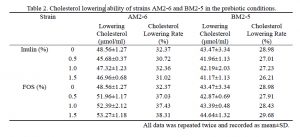
3 Determination of optimal rate of starter cultures
The synbiotic yogurt with cholesterol lowering ability was produced using the production starter cultures of AM2-6 and BM2-5. The production process of synbiotic yogurt with cholesterol lowering ability was based on the traditional production process of stirred yogurt according to GB 19302-2010 with some modification. To confirm the optimal production process, the optimal rate, inoculum and temperature were determined as above. The flow chart of development technology of synbiotic yogurt with cholesterol lowering ability was shown as Fig 1.
Inulin was widely used as the fat substitute in yogurt production processes. It forming a creamy structure, after mixing into the water (Li Y. et al, 2015). Therefore, skim milk powder was used for the production process of synbiotic yogurt with cholesterol lowering ability. Briefly, skim milk powder was 11.5% (w/v) hydrated with addition of 1.0% inulin and 1.5% FOS respectively (Li Y. et al, 2015). Then heated under 95℃ for 5 min. After rapidly cooled to 43℃, the production starter cultures was inoculated at the rate of 1:1, 2:1, 1:2, respectively (Li H. et al, 2008). The inoculum was 3 g/100g of raw milk and fermentation temperature was under 43℃ according to the result in section 3.6. The pH value, titratable acidity was shown in Fig 2, viable count and sensory evaluation score was shown in Table 3.
According to the fermentation ability of synbiotic yogurt with 1:1, 1:2, 2:1 rate of starter cultures in the conditions of 1.0% inulin and 1.5% FOS, AM2-6: BM2-5 at the rate of 2:1 showed a stronger fermentation ability (Fig 2). In the conditions of both 1.0% inulin and 1.5% FOS, the fermentation period was about 6 h (pH 4.6). Combine the result of viable count and sensory score, strain rate AM2-6: BM2-5 of 2:1 was considered as the optimal rate of the mixed starter cultures.
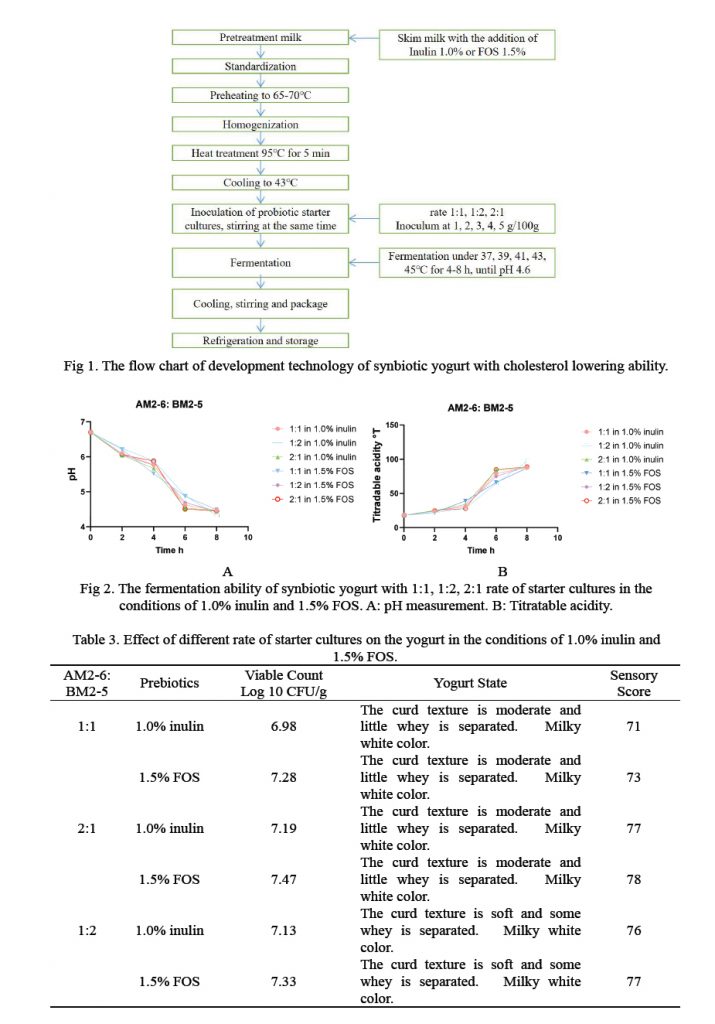
4 Determination of optimal inoculum of starter cultures
Skim milk powder was used for the production process of synbiotic yogurt with cholesterol lowering ability as mentioned above. The inoculation rate of starter cultures was 1:1 and the fermentation temperature was 43℃. The starter cultures was inoculated at 1 g/100g, 3 g/100g and 5 g/100g of inoculum in the condition of 1.0% inulin and 1.5% FOS. The pH value, titratable acidity was shown in Fig 3, viable count and sensory evaluation score was shown in Table 4.
According to the fermentation ability of synbiotic yogurt at different inoculum of starter cultures, 5% of inoculum was considered as the optimal inoculum in the conditions of both 1.0% inulin and 1.5% FOS (Fig 3). The fermentation period was about 6 h (pH 4.6).
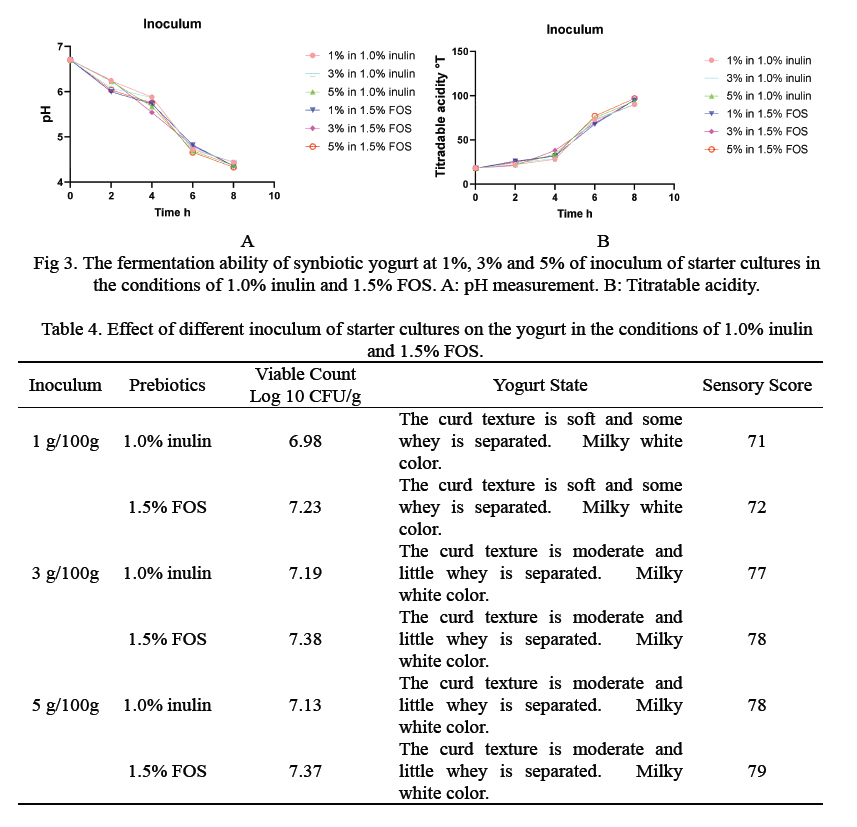
5 Determination of optimal fermentation period and temperature
Skim milk powder was used for the production process of synbiotic yogurt with cholesterol lowering ability as mentioned above. The starter cultures was inoculated at the rate of 1:1 and 3 g/100g of inoculum in the condition of 1.0% inulin and 1.5% FOS. The fermentation temperature was 37℃, 39℃, 41℃, 43℃ and 45℃. The fermentation period was indicated by pH and titratable acidity (Fig 4), viable count and sensory evaluation score was shown in Table 5.
According to the fermentation ability of synbiotic yogurt under different fermentation temperature, 43℃ was considered as the optimal temperature in the conditions of both 1.0% inulin and 1.5% FOS (Fig 4). The fermentation period was about 6 h (pH 4.6).
Compared to cholesterol lowering yogurt without prebiotic condition, the fermentation period of synbiotic yogurt with cholesterol lowering ability required more time to the end of the fermentation. The best fermentation observed under fermentation temperature under 43℃ and the fermentation period was about 6h.

6 Box-Behnken design of synbiotic yogurt with cholesterol lowering ability
In Box-Behnken design of the optimal production process of synbiotic yogurt with cholesterol lowering ability, 3 numeric factors and 3 responses were set. The 3 numeric factors were inoculation rate of strain AM2-6 and BM2-5, the inoculum and fermentation temperature (Table 6). And 3 responses were pH, titradable acidity and the viable count of each produced yogurt (Table 7). Two sets of designs were made under the conditions of 1.0% inulin and 1.5% FOS, respectively.
According to the Box-Behnken design, the final equation in terms of coded factors was performed as the following formula in the conditions of 1.0% inulin:
R1 = +4.18950 +0.015000 * X1 -0.011250 * X2 +0.010938 * X3。
R2 = +78.82 -0.62 * X1 +1.13 * X2 -2.25 * X3.
R3 = +7.08 +0.010 * X1 +0.091 * X2 -0.041 * X3 +7.500E-003 * X1 * X2 +0.067 * X1 * X3 +0.11 * X2
* X3.
The final equation in terms of coded factors was performed as the following formula in the conditions of 1.5% FOS:
R1 = +4.81 -0.062 * X1 -0.045 * X2 -0.032 * X3 -0.013 * X1 * X2 -2.500E-003 * X1 * X3 +0.023 * X2 *
X3 -0.062 * X12 -0.042 * X22 -0.017 * X32.
R2 = +68.40 +3.38 * X1 +2.50 * X2 +1.88 * X3 +1.00 * X1 * X2 +0.25 * X1 * X3 -1.00 * X2 * X3 +3.42
* X12 +2.17 * X22 +0.93 * X32.
R3 = +7.08 +0.056 * X1 +0.056 * X2 +0.10 * X3 +0.000 * X1 * X2 +0.038 * X1 * X3 -0.013 * X2 * X3
-0.012 * X12 +0.028 * X22 -0.11 * X32.
The effect of inoculation rate, inoculum and fermentation temperature on the pH, titradable acidity and viable count which designed by Box-Behnken design of the optimal production process of synbiotic yogurt with cholesterol lowering ability in the conditions of 1.0% inulin and 1.5% FOS. The most desirable conditions combined the numeric factors on the responses according to the Box-Behnken design was 1.77:1 of inoculation rate, 5 g/100g of inoculum, under 41.92℃ fermentation temperature in the condition 1.0% inulin, at the prediction of 98.0%. And 1.89:1 of inoculation rate, 5 g/100g of inoculum, under 42.87℃ fermentation temperature in the condition 1.5% FOS, repectively, at the prediction of 82.3%. The results of the orthogonal experiment by Box-Behnken design were consistent with the optimal condition results of single factor experiment in the actual operation which the inoculation rate of 2:1, 5 g/100g of inoculum and fermentation under 43℃. The most desirable conditions of development technology of synbiotic yogurt with cholesterol lowering ability by Box-Behnken design was shown as Fig 5.
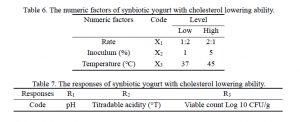

7 Physical and chemical analysis of synbiotic yogurt with cholesterol lowering ability
The optimal production process of synbiotic yogurt with cholesterol lowering ability was inoculation rate of 2:1, 5 g/100g of inoculum and fermentation under 43℃. And the fermentation period was about 6 h.
Physical and chemical index was determined as shown in Table 8. The standard strain Lb. plantarum NBRC 15891T was prepared as the production starter cultures for comparison. All data was within the standards by national standards GB 19302-2010.
Amino acid content was shown in Table 9. According to the propose by WHO/FAO, the cholesterol lowering yogurt reached the standard and it could be considered as a resource of good amino acid. And the concentrations of vitamins A, E, B1, B2, C were determined as shown in Table 10.

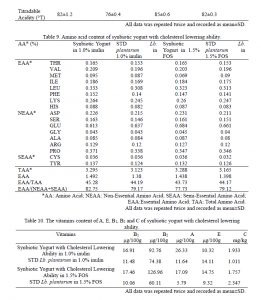
8 Storage of synbiotic yogurt with cholesterol lowering ability
The synbiotic yogurt with cholesterol lowering ability was refrigerated and stored under 4℃ for 21 days. The pH and titratable acidity was determined in every 7 days (Table 11). During the storage of synbiotic yogurt with cholesterol lowering ability, the number of viable count, acidity was decreased slightly as the same with cholesterol lowering yogurt.
Regardless of the level of inulin and FOS, the protective effect of prebiotics on the survival and viability of LAB has not been verified in the synbiotic yogurt (Hernandez H. et al, 2012). All the conditions of inulin and FOS confirmed the adequacy for bacteria growth in the synbiotic yogurt. The viable count has established 7 log cfu/g as a sum of LAB in yogurt and were in accordance with Codex Alimentarius (2010).
Table 11. The pH, titratable acidity and viable count of synbiotic yogurt with cholesterol lowering ability during 21 days of storage.
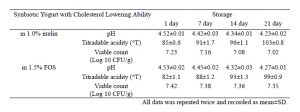
Conclusions
The Lb. plantarum strains AM2-6 and BM2-5 showed a certain cholesterol lowering ability in the prebiotic conditions. Although in the conditions of 0.5%, 1.0% and 1.5% of inulin condition, the two strains had a certain degree of cholesterol lowering ability, but both of their cholesterol lowering ability was decreased when collaborate with inulin. The cholesterol lowering ability of the two strains under the condition of 1.0% inulin is close to that in the blank condition. The cholesterol lowering rate of AM2-6 was 32.36% and BM2-5 was 27.23%. The optimal synbiotic effect on the two strains was in the condition of 1.0% inulin. Two strains showed an increased cholesterol lowering rate in the condition of 1.5% FOS. The cholesterol lowering rate of AM2-6 was 38.31% and BM2-5 was 29.74% in the condition of 1.5% FOS. The optimal synbiotic effect on the two strains was in the condition of 1.5% FOS.
The synbiotic yogurt with cholesterol lowering ability was produced using the production starter cultures of AM2-6 and BM2-5. The most desirable conditions combined the numeric factors on the responses according to the Box-Behnken design was 1.77:1 of inoculation rate, 5 g/100g of inoculum, under 41.92℃ fermentation temperature in the condition 1.0% inulin, at the prediction of 98.0%. And 1.89:1 of inoculation rate, 5 g/100g of inoculum, under 42.87℃ fermentation temperature in the condition 1.5% FOS, repectively, at the prediction of 82.3%. The results of the orthogonal experiment by Box-Behnken design were consistent with the optimal condition results of single factor experiment in the actual operation which the inoculation rate of 2:1, 5 g/100g of inoculum and fermentation under 43℃.
Acknowledgment
Specially grateful to the professor Menghebilige provided the relevant experimental conditions in the course of the completion of the present study.
Sarengaole1,2, Ch.Tsend-Ayush1, Bayinjirigala3, Monhebilige2
1 Food Processing Technology of Mongolian University of Science and Technology, Mongolia.
2 Key Laboratory of Dairy Biotechnology and Engineering, Ministry of Education, China; Inner Mongolia Agricultural University, Inner Mongolia, China.
3 College of Animal Science; Inner Mongolia Agricultural University, Inner Mongolia, China.